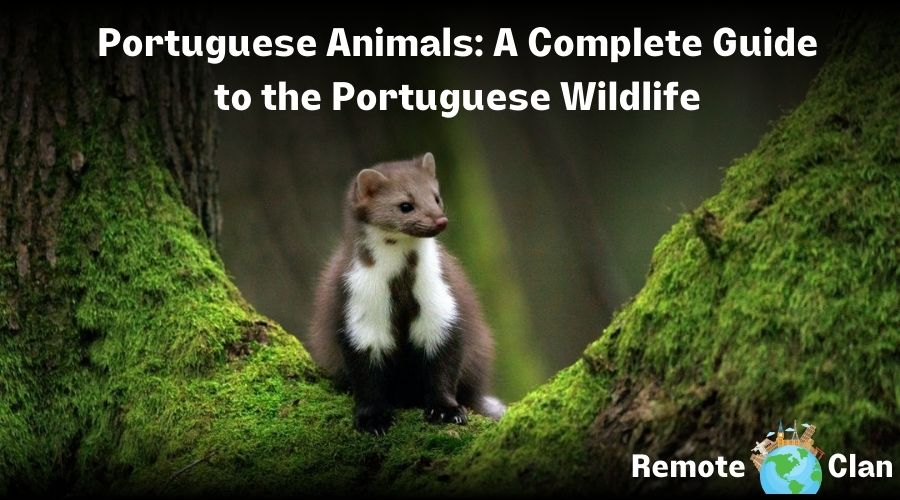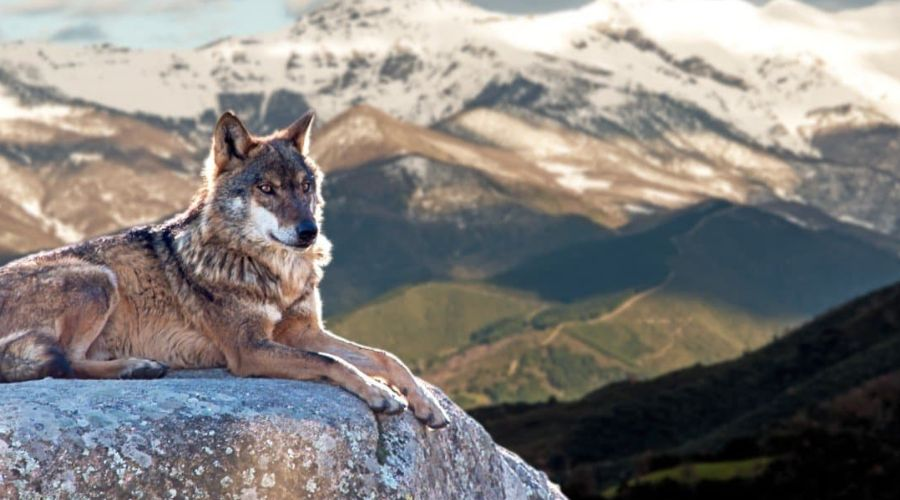
You can see several iconic Portuguese animals, such as the Iberian Lynx and Iberian Wolf while traveling through Portugal. Off the coast, the waters are rich with marine life, including the playful Common Dolphin and the majestic Fin Whale. In the rivers and wetlands, the European Otter and the Iberian Ribbed Newt showcase the diverse aquatic life. Each of these animals not only adds to the natural beauty of Portugal but also represents an essential part of its ecological tapestry
Famous Portuguese Animals
Famous Portuguese Animals are Griffon Vulture, Common Dolphin, Azores Bullfinch, Iberian Lynx, red foxes, Red squirrel, Iberian Wolf, Benelli's eagle, black stork, white stork European wildcat, Portuguese Water Dog and Griffon Vulture. More details about these famous Portuguese wildlife animals are listed below.
Griffon Vulture
A large bird of prey found in the Portuguese mountains.
Common Dolphin
Frequently spotted in the Atlantic waters around Portugal, known for their playful nature.
Azores Bullfinch
A rare bird species endemic to the Azores islands.
Iberian Lynx
A critically endangered species, known for its distinctive ear tufts and spotted coat.
Iberian Wolf
An iconic predator of the Iberian Peninsula, revered in local folklore.
Portuguese Water Dog
A well-known dog breed originating from Portugal, famous for its swimming ability.
Griffon Vulture
A large bird of prey found in the Portuguese mountains.
Barbary Macaque
Though primarily associated with Gibraltar, these monkeys are also found in parts of Portugal.
Mediterranean Chameleon
The only chameleon species found in Portugal, primarily in the southern regions.
Portuguese Man o' War
A marine creature known for its venomous tentacles, often found in Portuguese waters.
Red Deer
Common in the forested regions of Portugal, especially in the north.
Main Types of Portuguese Animals
The main types of Portuguese animals include mammals like the Iberian lynx, Azores bullfinch, Iberian imperial eagle, dolphins and whales, reptiles and amphibians like the Mediterranean chameleon and Iberian ribbed newt, as well as a wide range of insects and arthropods.
From the coastal regions to the mountainous interiors, Portugal is home to a myriad of wildlife, each uniquely adapted to their environment. Here are more details on these animals.
Mammals
In the forests and mountains, mammals such as the Iberian lynx, which is critically endangered, and the Iberian wolf can be found. Other mammals include the wild boar, red deer, and the common genet, a small nocturnal creature.
Birds
Portugal is a haven for birdwatchers, with exotic species, like the Azores bullfinch, unique to the Azores, and the Iberian imperial eagle. Other birds include the flamingo, stork, and various seabirds along the coastline.
Marine Life
The Atlantic Ocean along Portugal's coast is teeming with marine life. This includes various species of dolphins, such as the common and bottlenose dolphins, and whales like the sperm whale. There's also a rich diversity of fish and other sea creatures in its waters.
Reptiles and Amphibians
Reptiles like the Iberian ribbed newt and the Mediterranean chameleon are found in Portugal. The country also hosts various species of turtles and snakes, adapted to both land and aquatic environments.
Insects and Arthropods
Portugal's insect and arthropod population is vibrant and includes numerous species of butterflies, bees, spiders, and the unique Portuguese man o' war, known for its painful sting.
Each of these animals plays a crucial role in Portugal's ecosystems, contributing to the rich biodiversity that the country is known for. Conservation efforts are ongoing to protect these species, especially those facing threats from habitat loss and climate change.
Which are the Dangerous Wild Animals in Portugal?
The dangerous wild animals in Portugal are Iberian Wolf, Wild Boar, Lataste's Viper, Montpellier Snake, Blue Shark, Portuguese Man o' War, European Black Widow, Mediterranean Scorpion. Detailed information about these animals are listed below.
Iberian Wolf
This large predator, while generally avoiding humans, can be dangerous under certain circumstances.
Wild Boar
Known for their unpredictability and aggressiveness, especially when young or cornered.
Lataste's Viper
A venomous snake found in northern Portugal, its bite can be painful and medically significant.
Montpellier Snake
This mildly venomous snake can cause discomfort but is not usually life-threatening.
Blue Shark
Occasionally spotted off the coast, these sharks can pose a danger if encountered while swimming or surfing.
Portuguese Man o' War
Not a true jellyfish but a siphonophore; its sting is notoriously painful and potentially harmful.
European Black Widow
A venomous spider whose bite can cause severe reactions, especially in vulnerable individuals.
Mediterranean Scorpion
Its sting can be painful and, in rare cases, lead to allergic reactions.
What are the Names of Portuguese Sailor Animals?
The names of Portuguese Sailor (sea) Animals are Common Dolphin, Portuguese Man o' War, Blue Shark, Loggerhead Sea Turtle, Atlantic Bluefin Tuna, Sperm Whale, Seagull, Bottlenose Dolphin, Flying Fish, and the Moon Jellyfish. Additional information about Portuguese sailor animals is provided here.
-
Common Dolphin: Known for swimming alongside boats, a symbol of good luck for sailors.
-
Portuguese Man o' War: Recognizable by its sail-like float, infamous for its sting.
-
Blue Shark: A frequent, respected sight in Portuguese waters.
-
Loggerhead Sea Turtle: These migratory turtles are a common sight in warmer Portuguese currents.
-
Atlantic Bluefin Tuna: Integral to Portuguese fishing traditions, often seen during expeditions.
-
Sperm Whale: A part of Portuguese maritime lore, occasionally sighted by sailors.
-
Seagull: Ubiquitous in Portuguese ports, a constant maritime companion.
-
Bottlenose Dolphin: Like the common dolphin, these are known for accompanying ships.
-
Flying Fish: Fascinating to sailors for their ability to glide out of the water.
-
Moon Jellyfish: Commonly seen floating near the surface in Portuguese waters.
These marine species are closely linked to Portugal's rich maritime history and have been key figures in the experiences of Portuguese sailors. Each of these animals holds a unique place in the maritime lore and ecosystem, from the playful antics of dolphins to the majestic presence of the sperm whale, and the mysterious allure of the Portuguese Man o' War.
What is Portugal's National Animal?

Portugal's national animal is the Iberian Wolf (Canis lupus signatus). This subspecies of the gray wolf is native to the Iberian Peninsula, which includes both Portugal and Spain. The Iberian Wolf holds a significant place in Portuguese culture and heritage, symbolizing wildness and freedom. Despite facing challenges such as habitat loss and human-wildlife conflict, it is a protected species, and conservation efforts are ongoing to ensure its survival and the preservation of Portugal's natural heritage.
10 Best Places to See Wildlife in Portugal
10 best places to see wildlife in Portugal are Peneda-Gerês National Park, Ria Formosa Natural Park, Douro International Natural Park, Arrábida Natural Park, Berlengas Nature Reserve, Faia Brava Reserve, Montesinho Natural Park, Azores, Madeira, Lousã and Açor Mountains. Here is more information on these wildlife places of Portugal.
Peneda-Gerês National Park
Located in the north, this park is ideal for spotting the Iberian Wolf, wild Garrano horses, and a variety of birds.
Ria Formosa Natural Park
Situated in the Algarve, this coastal lagoon system is a haven for birdwatchers, with flamingos, spoonbills, and other migratory birds.
Douro International Natural Park
Bordering Spain, this area is known for its birds of prey, including the golden eagle and the Egyptian vulture.
Arrábida Natural Park
Near Lisbon, this park offers a chance to see dolphins, including the common and bottlenose varieties, in the Sado Estuary.
Berlengas Nature Reserve
Accessible by boat from Peniche, this archipelago is a nesting site for seabirds like puffins and a variety of marine life.
Faia Brava Reserve
As part of the Côa Valley, this private reserve is a sanctuary for birds, including the endangered black vulture.
Montesinho Natural Park
Located in the northeast, this park is a good place to observe the Iberian wolf and other mammals like the wild boar.
Azores
The archipelago is renowned for whale and dolphin watching, with species like the sperm whale and various dolphins being common.
Madeira
Known for its unique bird species, such as the Madeira firecrest, and marine life like monk seals.
Lousã and Açor Mountains
These areas are known for their wild boar populations and a variety of bird species.
Male and Female Animals in Portuguese
Male and Female Animals in Portuguese are listed below.
Male Portuguese Animals
-
Cão (Dog)
-
Gato (Cat)
-
Cavalo (Horse)
-
Touro (Bull)
-
Porco (Pig)
-
Carneiro (Sheep)
-
Bode (Goat)
-
Galo (Rooster)
-
Pato (Duck)
-
Coelho (Rabbit)
Female Portuguese Animals
-
Cadela (Dog)
-
Gata (Cat)
-
Égua (Horse)
-
Vaca (Cow)
-
Porca (Pig)
-
Ovelha (Sheep)
-
Cabra (Goat)
-
Galinha (Hen)
-
Pata (Duck)
-
Coelha (Rabbit)
Frequently Asked Questions About Portuguese Wildlife Animals
1. What Animals are Used in Portuguese Bullfighting?
In Portuguese bullfighting, the primary animal used is the Iberian bull. Unlike Spanish bullfighting, the bull is not killed in the ring, and the focus is more on the skill of the horsemen (cavaleiros).
2. What is Portugal's National Animal?
The national animal of Portugal is the Iberian Wolf. This species is native to the Iberian Peninsula and holds significant cultural importance in Portugal.
3. Are There Any Endangered Animals in Portugal?
Yes, there are endangered animals in Portugal, including the Iberian Lynx, which is one of the most endangered cat species in the world.
4. Can You See Dolphins in Portugal?
Yes, dolphins can be seen in Portugal, especially in areas like the Sado Estuary and off the coast of the Algarve and Azores.
5. Where Can You See Wildlife in Portugal?
Wildlife in Portugal can be observed in various locations such as the Peneda-Gerês National Park, Ria Formosa Natural Park, and the Azores.
6. What are Some Common Birds Found in Portugal?
Common birds in Portugal include the Azores bullfinch, the Iberian imperial eagle, and various species of storks and flamingos.
7. What is the largest national park in Portugal?
The largest national park in Portugal is Peneda-Gerês National Park.
